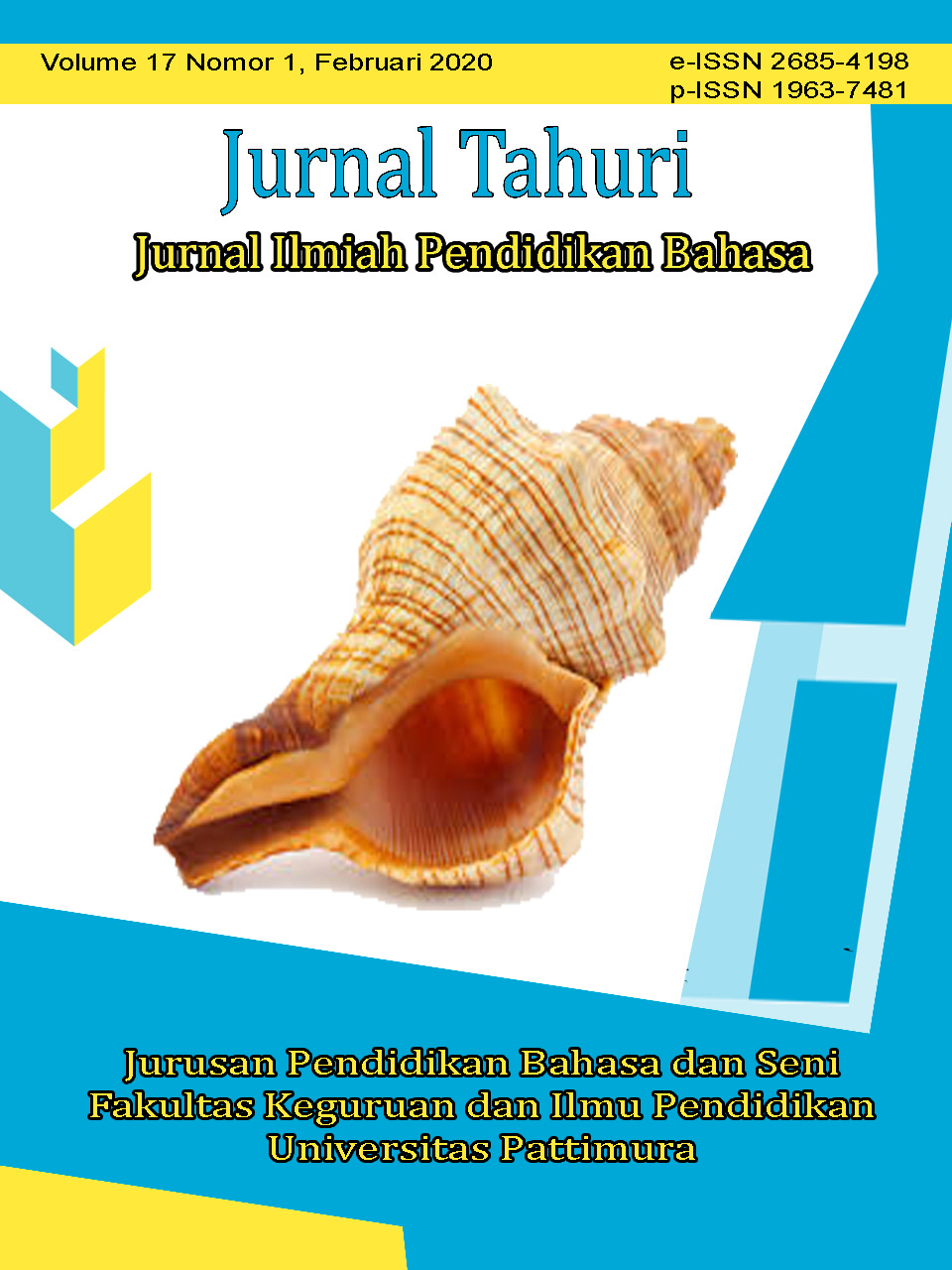THE IMPLEMENTATION OF COLLABORATIVE WRITING IN IMPROVING STUDENTS WRITING SKILL AT 11TH GRADE OF SCIENCE CLASS AT SMA PERTIWI AMBON
Abstract
As one of productive skill in the foreign language context, writing skill can be figured as the most difficult skill for EFL learners. Therefore EFL teachers should implement meaningful teaching technique to help learners improve their writing skill. One of the techniques that recommended by the experts is collaborative writing. It is the teaching technique which is focused on work collaborative in writing process. This technique is adapted from the collaborative learning strategy in which this technique is useful to treat students to work collaboratively in writing process. The collaborative works can be done in pairs or in a group. Therefore, this study is aimed at describing the useful of implementing collaborative writing technique in improving the students’ writing skill. The research consists of the subject from SMA Pertiwi Ambon comprised of 13 students in XI-Science class. The data was collected from classroom observation and field notes, test, questionnaire and interview. The research methodology that used in this research was classroom action research under mix method qualitative-quantitative design. The findings of the study revealed that by implementing the collaborative writing technique, the students can improve their writing skill and it can be shown through the result of their writing paragraphs. Through the implementation of this technique, the students can share their ideas, organize their ideas, write the outline and develop their writing after they work both in pairs or in a group. They also did a peer feedback, revise and write their final product of their writing. Moreover, they have positive respond towards this technique and build a good interaction in working on their writing paragraphs. As the conclusion, this technique is useful to be implemented in classroom writing activities. To implement this technique optimally, teachers need to consider the characteristics of students background knowledge on writing in English, the given topic and the time for learners to practice their writing skill. The more the students have chance to work collaborative the better they produce their writing skill.
Downloads
References
Alma Milena Robayo Luna & Luz Stella Hernandez Ortiz. (2013). Collaborative Writing to Enhance Academic Writing Development Through Project Work. A Colombian Journal for Teachers of English, 130-146.
Brown, H. D. (2002). Teaching by Principles An Interactive Approach to LAnguage Pedagogy. San Fransisco, California: Longman.
Bukhari, S. S. (2016). Mind Mapping Techniques to Enhance EFL Writing Skill. International Journal of Linguistics and Communication, 58-77.
Cooper, M. M. (1986). The Ecology of Writing. College English, 48, 364-75.
Costello, P. (2011). Effective Action Research. New York: Continuum.
Creswell, J. W. (2013). Research Design. London, UK: SAGE.
Fong, L. S. (2012). Benefits of Collaborative awriting for ESL Advanced Diploma Learners in the Production of Reports. US-China Education Review, 396.
Gibbons, P. (2002). Scaffolding language and scaffolding learning: Teaching second language learners in the mainstream classroom. Portsmouth, NH: Heinemann
Harmer, J. (2002). The Practice of English Language Teaching. UK: Pearson Longman.
Hedge,T. (2005) Writing. Oxford: Oxford University Press. Retrieved from http://www.tesl-ej.org/ej35/r3.pdf
Homstad, T and Thomson, H. 1994. Writing Theory and Practice in the Second Language Classroom: A Selected Anotated Bibliography. German: University of Minnesota.
Huot, B. (1996). Toward a New Theory of Writing Assessment. College Composition and Communication, 549-566.
Hyland, K. (2003) Second language writing, Cambridge University Press.
Idoia Elola & Ana Ozkoz. (2010). COLLABORATIVE WRITING: FOSTERING FOREIGN LANGUAGE AND WRITING CONVENTIONS DEVELOPMENT. Language Learning & Technology, 51-71.
International reading Association & National Council of Teacher English. (2010). Standards for the Assessment of Reading and Writing. International Reading Association and the National Council of Teachers of.
Kroll, B. (2003). Exploring the Dinamics of Second Language Writing. United State of America: Cambridge Universiity Press. Retrieved from http:// catdir.loc.gov/catdir/samples/cam034/2002074049.pdf
Lombana, C. H. (2002). Some issues for the teaching of writing. PROFILE Issues in Teachers’Professional Development, 3(1), 44-51.
Mohammad Khatib & Hussein Meihami. (2015). Languaging and Writing Skill: The Effect of Colaborative Writing on EFL Learners' Writing Performance. Advances in Language and Literacy Studies, 203-211.
Msanjila, Y. P. (2005). Problems of writing in Kiswahili. Nordic Journal of African Studies,15-25.
Mutwarasibo, F. (2013). Supporting the Development of Learners' Academic Writing throuh Collaborative Process Writing. Journal of Instructional Pedagogies, 1-13.
Nunan, D. (1999) Second Language Teaching & Learning. Boston: Heinle & Heinle.
Phipps, Maurice, Cindy Phipps, Susan Kask, and Scott Higgins. 2001. University
Learners’ Perception of Cooperative Learning: Implications for Administrators and Instructors. The Journal of Experiential Education. Retrieved fromhttp://journals.sagepub.com/doi/pdf/10.1177/105382590102400105
Richard , Jack C. and Willy A, Renandya, Methodology in Language Teaching: an anthology of current practice. Cambridge: Cambridge University Press, 2002
Rune Bagetune & Barbara Wasson. (2006). Self-Regulated Learning and Open Writing. European Journal of Education. Research, Development and Policy, Pages 453–472 . Volume 41, Issue 3-4.
Storch, N. (2005). Collaborative writing: Product, Process, and Learners' reflections. Journal of Second Language Writing, 153-173.
Storch, N. (2011). Collaborative Writing in L2 Contexts: Processes, Outcomes, and Future Directions. Annual Review of Applied Linguistics, 275-288.
Vygotsky, L.S. (1978). Mind in society: the development of higher psychological processes.Cambridge, MA: Cambridge University Press.
Weigle, S. C. (2002). Assessing Writing: Ernst KlettSprachen. Retrieved from https://www.abebooks.com/9783125334410/Assessing-Writing-3125334411/plp. Web. 12 Jan 2018.
Wells, G. (2000). Dialogic inquiry in education.Building on the legacy of Vygotsky.In C. Lee & P. Smagorinsky (Eds.), Vygostkian perspectives on Literacy research.Constructing meaning through collaborative inquiry (pp. 51–85). Cambridge, UK: Cambridge University Press.
Wenger, Etienne (1998). Communities of Practice: Learning, Meaning, and Identity. Cambridge: Cambridge University Press. ISBN 978-0-521-66363-2.
William Condon & Diane Kelly-Riley. (2004). Assessing and Teaching What We Value: The Relationship between College-Level Writing and Critical Abilities . Assessing Writing, 56-75.
Yanghee Kim & Jiyoung Kim. (Volume 7 Issue 2). Teaching Korean University Writing activity:Balancing the Process and the Genre Approach. Asian EFL Journal.
Zamel, V. (1982). Writing: The Process of Discovering Meaning. TESOL Quarterly, Vol. 16, No. 2., 195-209.




